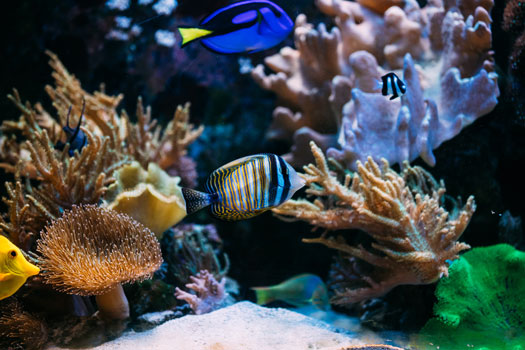- Your shopping cart is empty!
What’s the Quickest Method for Cycling a Saltwater Aquarium?

Cycling a saltwater aquarium refers to the process involved in establishing the quality of the water so it can support marine species. The establishment of an aquatic ecosystem is more accurately described as the nitrogen cycle because it’s a biochemical process. It involves factors beyond salinity, pH, and the presence of certain minerals. Similar to freshwater tanks, the nitrogen cycle can take between four to five weeks to complete, and you always need to have all the essential saltwater aquarium supplies on hand no matter how quickly you cycle the tank, but there are ways to speed things up.
Professional Installation
It’s always better to take your time so you improve upon your knowledge of marine biology and biochemistry, but there are situations that call for a speedy setup. One example would be gifting a nice reef tank in time for the holidays. It’s difficult to push the cycle too fast, but you can always “borrow” a filter from an established saltwater aquarium that has already been colonized by Nitrobacter to speed up the cycle. This would be the fastest option, but you still need to add liquid bacteria.
Using Established Water, Filters, and Substrate
This is very similar to a professional installation, but you would be sourcing your saltwater tank components from a shop or a secondhand aquarium setup. The suspect part here is that the sources have to be trusted because you don’t want to introduce parasites to your new tank, and you’ll have to transfer at least 80 percent of established water and all of the established live rock. When you have access to such sources, you’ll only need to wait about a week for the established filter to work its magic and allow liquid beneficial bacteria to colonize the aquarium walls, rocks, and decorations.
Live Rock
By far, the best way to cycle a saltwater tank is to let nature take its course using synthetic “Real Reef Rock” and adding either the very powerful “Nite-Out” liquid bacteria in conjunction with Reed Mariculture liquid oyster feast to gradually feed the bacteria or Dr. Tim’s bacteria in conjunction with his ammonia to feed. Many saltwater fish keepers begin with marine tanks that gradually become gorgeous reef tanks over time. Reef tanks are at the pinnacle of the aquarium hobby, and they invariably feature live rock. Curing live rock from the beginning will cut down the cycling process by a few weeks because it contains nutrients that stimulate bacterial growth. After live rock has been cured three weeks in balanced saltwater, this would be a good time to add some hermit crab species, which consume waste and algae. Remember to turn off the lights (you don’t need to grow algae here) and run the protein skimmer, but set it up to where it’s not collecting anything in its collection cup. You want to feed the bacteria, not starve it. It’s important to have it on so the bacteria gets all the air it can use—and it uses a lot!
Bottled Bacteria
Freshwater tanks can be established in just a couple weeks with this method, by adding plants first then fish on the third week. You shouldn’t expect the same speedy cycling in a marine tank, but dosing saltwater with bacteria from a bottle can accelerate establishment considerably. Make sure to closely follow directions that come with the bottle. To be on the safe side, you should test water levels with a master kit after adding the aforementioned food for the bacteria. Let the food break down, decompose, and dissolve to test if the Nitrobacter colonies can handle all the nitrates.
It’s crucial to ensure you have all the supplies necessary to properly care for your saltwater aquarium. Whether you need a dosing pump, nutritious fish food, filtration, LED lighting, or any other supply, you can find what you’re looking for at Aquatic Warehouse. Stop by our store located in Kearny Mesa, order what you need from our website and have it shipped to you, or give us a call at 858-467-9297 if you have any questions.
